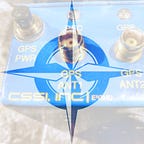Global RVSM Monitoring Capability with MODE C Altitude Recording
One of the key data components for Reduced Vertical Separation Minimum (RVSM) monitoring and height-keeping performance testing is capturing the Pressure Altitude Flown while in RVSM from the aircraft. Another component is independent Global Positioning System (GPS) height and position performance which can be collected with an onboard RVSM Monitoring GPS based Monitoring toolkit.
RVSM
RVSM reduced the Vertical Separation Minima between aircraft flying in flight levels 29,000–41,000 feet altitudes from 2,000 ft to 1,000 feet of vertical separation — this allows for more traffic access to the thinner atmosphere to reduce delays while maintaining safety.
The RVSM Monitoring and testing confirms the aircraft height-keeping performance and the test is required every 2 years or 1,000 flight hours (whichever is longer).
See this article for more on RVSM and how it enhances airspace safety.
Pressure Altitude Recording Problems ⚠
The Pressure Altitude Flown is observable by both the Pilot via instruments and the Air Traffic Control but many Regional Monitoring Agencies (RMA) do not have the infrastructure nor ability to request those ATC Pressure Altitude recordings. This poses a significant problem when the Regional Monitoring Agency needs to calculate the Altimetry System Error or vertical safety tolerance of the aircraft performance in RVSM airspace based on the GPS data alone.
If the RMA has the three data components it needs (the aircraft Pressure Altitude reports, independent GPS height and position data, and the Meteorological weather data for the region of the flight), the RMA can determine the Altimetry System Error and certify the aircraft is safe to fly in the reduced separation environment.
In the Pacific region RVSM Monitoring flights for instance, the height keeping performance data could be collected with an onboard independent GPS based Monitoring System but the pressure altitude reporting would need to come from somewhere else — the Pacific Air Traffic Control simply did not have the capability for real time surveillance and tracking prior to space based ADS-B.
Often the Pacific aircraft would be monitored by the GPS based Monitoring System and then the Digital Flight Data Recorder (DFDR) altitude records would need to be downloaded shortly after the flight landed to ensure they were not erased. This often came with a significant cost if the DFDR required specialist assistance or, if the download did not happen, the RVSM Monitoring flight would need to be redone.
CSSI’s Global RVSM Monitoring Solution 🌐
CSSI’s solution to this Pressure Altitude Recording problem was to integrate a MODE C listening system into our design for the GPS based RVSM Monitoring Toolkit — CSSI’s E2GMU.
The CSSI E2GMU for aircraft RVSM Monitoring comes standard with an Altitude Recording Device (ARD) and a MODE C Antenna that listens for the target aircraft MODE C responses to external MODE C requests and then the ARD system records that data (UTC Time, Flight Level Reported, and Squawk).
For the E2GMU or any aircraft GPS based RVSM Monitoring Toolkit to not require any special aircraft installation regulations, the system has to be passive listening device and cannot project a signal into the airspace to trigger the MODE C response. The E2GMU is therefore considered by civil aviation authorities to be a portable electronic device and it makes it easier to install the system in any aircraft with minimal impact to the crew.
The ARD listening system works the best when the RVSM Monitoring flight occurs where there is consistent MODE C ground system surveillance
OR
The ARD works best when the RVSM Monitoring flight occurs where there is consistent population of other aircraft traffic to interrogate the target aircraft MODE C.
Basically any mixture of both Ground and Traffic in the RVSM Monitoring test flight region will achieve a good, consistent data result so operators will want to flight plan for region with maximum amounts of both sources. The ARD should collect a MODE C response once every 6 seconds for about 30 minutes of straight and level RVSM test flying when the ARD is in optimal conditions.
Once the RVSM flight is completed, the E2GMU stores the GPS and ARD data on a Wi-Fi capable Tablet for easy transfer of data over the internet through email or any number of applications. The collected RVSM flight data is submitted to the CSSI RVSM for coordination with the Regional Monitoring Agency responsible for the country the aircraft is registered in.
The Regional Monitoring Agency will calculate the Altimetry System Error based on the E2GMU data provided and issue RVSM approvals for the aircraft if the performance is within safety tolerances. CSSI RVSM will then notify when the RMA has completed their work and CSSI RVSM will provide an unofficial result.
You can find your Regional Monitoring Agency and lookup your RVSM Approval history in this article.
About CSSI, Inc.
CSSI RVSM has proudly served the world’s RVSM monitoring needs since July 1999, having supported over 20,000 monitoring flights worldwide. CSSI RVSM is ready to help you complete the RVSM monitoring flight required to maintain RVSM approval for your aircraft.
CSSI RVSM also offers the E2GMU portable aircraft RVSM Monitoring toolkits for sale to aviation industry partners for on demand flight testing. Contact CSSI for a quote today.
Contact CSSI RVSM at link below!
